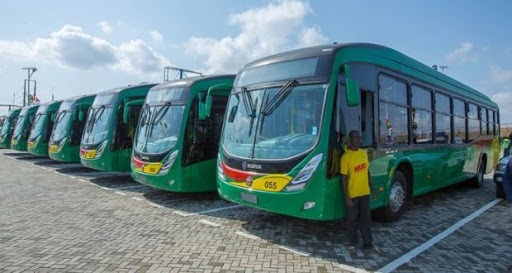A video in circulation on social media shows that a number of buses operated under the Bus Rapid Transit (BRT) has been grounded.
The video has raised concerns over why such huge investment by the state could be allowed to go waste.
Here are 10 facts on the operations of the BRT.
1. The Bus Rapid Transit (BRT) transportation system was to be implemented under the Urban Transport Project (UTP) to deliver fast and affordable transportation for commuters in Accra and Kumasi. When you read the June 2012 World Bank mission agreement with the government on an action plan to right track the implementation, the project was to start in the Greater Accra (Ga East, Accra, Ga West, Tema) and Ashanti region (Ejisu-Juaben Kumasi).
2. The UTP was jointly funded by the World Bank, Agence Francaise de Development (AFD), the Government of Ghana, and the Global Environment Facility Trust Fund at the cost of $95 million.
3. The 16th July 2014 report of the Parliament’s Committee on Roads and Transport puts the procurement sum of the agreement between the Government of Ghana and Sweden’s SCANIA CV AB at $110,733,461,00. SCANIA CV Aktiebolg of Sweden was to supply 295 buses built at their plant in South America, Brazil.
4. The government took delivery of 245 buses in 2016. Scania brought Marco Polo Low Entry City buses which cost Ghana $251,600 per bus, making the total cost of the buses $61,642,000. This cost did not include VAT, NHIL and customs duties at the port. Per the contract agreement, the supplier of the buses Scania CV Aktiebolg of Sweden was also to supply spare parts, and training of local staff and technicians.
5. Together with the cost of developing the infrastructure, and the dedicated lanes in the earmarked areas in Greater Accra and Ashanti region, the project cost the country about $151 million. Out of this, only $ 7 million is a grant from the Global Environmental Fund. The rest are loans from the International Development Association, Agence Francaise de Development (AFD) and the World Bank.
6. The Project Appraisal Document of the World Bank and the Credit Agreement covering the UTP suggest that the BRT should have been completed by December 2012. Then President, John Mahama promised the BRT was going to be ready by September 2012 when he cut the sod for the commencement of works for the BRT on the Graphic Road on the 2nd of February, 2011.
7. The promises moved from December 2012, March 2013, September 2013, June 2014, June 2015 and September 2015. All these deadlines were not honoured. All this while, as of December 3, 2012, the World Bank had made available $45m for this project.
8. In 2012, the project shifted focus from the Kasoa-CBD corridor to the Amasaman corridor. It was believed that since the Kufuor Government had invested in and opened up the Achimota-Ofankor road network it was going to be possible and relatively easy to insert a functional BRT system with very minimal investments. That did not work too.
9. Some months ago, Joy News wrote to the World Bank for a comment on this project and the Bretton Woods institution said “In a post-completion assessment of the project, the Bank rated the implementation performance unsatisfactory. The procurement of buses by the government represented a deviation from the original plan of establishing a limited competitive regime for public transport operations along major routes. The project envisaged that the private sector operators would be responsible for providing the specified quality of buses for operations along designated routes, based on a route license issued by the regulator. Government intervention in purchasing buses meant that the element of private sector initiative and investment in passenger transport in the bid to improve mobility is lost.”
10. Per the parliament record, the useful economic life of the SCANIA buses was noted to be 10 years. This means we have barely 3 years to generate productivity from these 245 buses. They are now essentially nearing a liability stage that can offer the country no viability to generate returns to defray the cost of the loans accrued.
Latest Stories
-
Will Ghana’s democracy stand the test of time in the 2024 elections?
25 mins -
Hindsight: Dreams fairytale run proved one thing; it is possible
2 hours -
God makes rulers, not you; you can’t choose your successor – Mahama to Akufo-Addo
3 hours -
Contributors own SSNIT, they must decide who becomes its Director-General – Austin Gamey
3 hours -
Move away from theory-based learning towards practical learning approaches – AUCC President to students
4 hours -
Haaland scores as Manchester City beat Nottingham Forest
5 hours -
Villas-Boas elected Porto president
5 hours -
Situation on frontline has worsened, Ukraine army chief says
5 hours -
US doctor describes witnessing starvation in northern Gaza
5 hours -
CAFCC: RS Berkane make final after USM Alger refused to play 2nd leg over Moroccans’ jersey
5 hours -
Elon Musk in China to discuss enabling full self driving
5 hours -
PSG clinch Ligue 1 title after Lyon’s win over Monaco
7 hours -
Guinness Ghana sets the pace at Ghana Beverage Awards with six awards
8 hours -
Burkina Faso suspends BBC, VOA radio broadcasts over killings coverage
8 hours -
Nicole Kidman honoured with AFI Life Achievement Award
8 hours

